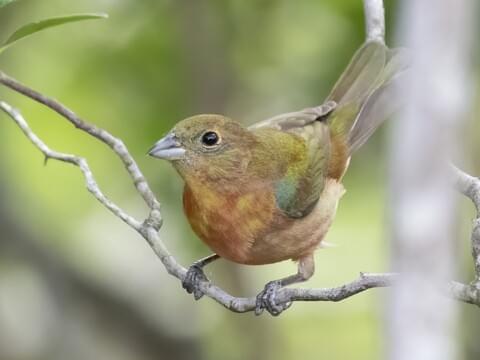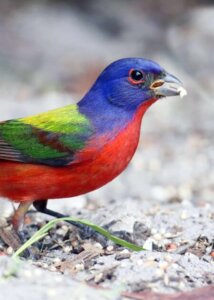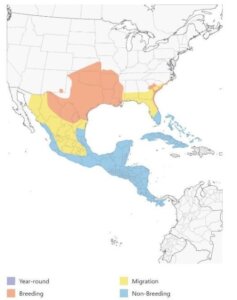How to Identify a Painted Bunting: Tips for Birdwatchers
How to identify a Painted Bunting? Look for its vibrant colors and distinct patterns.
Males are especially striking with their blue heads, red underparts, and green backs. Bird watchers often marvel at the Painted Bunting’s beauty. This small, colorful bird is a favorite among enthusiasts. Identifying one can be a delightful experience. Male Painted Buntings are easy to spot due to their bright colors.
Females and young birds, however, are more subtle with their greenish tones. Knowing what to look for and where to find them can make your bird-watching adventure more rewarding. In this blog post, we’ll guide you on how to identify a Painted Bunting easily. Ready to spot one of nature’s most colorful birds? Let’s get started!
Introduction To Painted Buntings
The Painted Bunting is a small, colorful bird. It is often called one of the most beautiful birds in North America. Birdwatchers and nature lovers are always excited to spot this bird. Its vibrant colors and unique patterns make it stand out.
Unique Characteristics
The male Painted Bunting has striking colors. It has a blue head, green back, and red underparts. These bright colors make it easy to identify. The female is less colorful. She has greenish-yellow feathers, perfect for blending into the surroundings. Both males and females are small, about 5 inches long.
Habitat And Range
Painted Buntings prefer dense, shrubby areas. They live in thickets, woodland edges, and overgrown fields. During summer, they are commonly found in the southeastern United States. In winter, they migrate to Central America and the Caribbean. They need places with plenty of food and cover to thrive.

Credit: www.midtownmag.com
Physical Appearance
The Painted Bunting is one of the most colorful birds in North America. Its vibrant colors and unique features make it easily recognizable. This section will help you identify a Painted Bunting based on its physical appearance.
Color Patterns
Male Painted Buntings are known for their bright, vivid colors. They have a blue head, red underparts, and green back. Their eyes are surrounded by a thin red ring. Females and young males are less colorful. They are mostly green and yellow, blending well with their surroundings.
Size And Shape
The Painted Bunting is a small bird. It measures about 5.5 inches in length. Its wingspan is around 8.3 inches. The bird has a stout, conical bill, perfect for seed-eating. Its body is stocky and its tail is short and notched.
Behavioral Traits
Painted Buntings are small, vibrant birds that captivate bird watchers. Their unique behaviors are as striking as their colors. Understanding these behaviors can help you identify them easily.
Feeding Habits
Painted Buntings often feed on seeds and insects. They prefer foraging on the ground or in low bushes. They love millet and sunflower seeds. You might see them at bird feeders, especially during migration.
They are not shy about visiting yards with birdseed. If you spot a small, colorful bird eating seeds from the ground, it could be a Painted Bunting.
Mating Rituals
Their mating rituals are fascinating. Male Painted Buntings sing to attract females. Their song is a high-pitched, sweet melody. They often sing from high perches to be seen and heard.
During courtship, males display their vibrant plumage to impress females. They may also perform aerial displays. If you see a brightly colored bird singing and showing off, you might be watching a Painted Bunting’s mating ritual.
Vocalizations
The painted bunting is a bird with a vibrant appearance and melodious vocalizations. Understanding their sounds helps bird enthusiasts identify them. This section delves into the vocalizations of the painted bunting, exploring their song types and call differences.
Song Types
Painted buntings have two main song types. The first type is a series of high-pitched notes. These notes are often described as musical and sweet. The second type is a more complex song. It includes a mix of trills and whistles. Males use these songs to attract mates and defend their territory. Each male has a unique song. This helps them stand out among others.
Call Differences
Painted buntings also have different call differences. These calls are shorter than their songs. The most common call is a sharp “chip” sound. This call is used to signal alarm or alert other birds. There is also a softer, more conversational call. This call is used during social interactions. Recognizing these calls can help in identifying painted buntings in the wild.
Identifying Painted Buntings In The Wild
Painted Buntings are one of the most beautiful birds in North America. Their vibrant colors make them easy to spot. Identifying these birds in the wild can be a fun and rewarding experience. Here, we will explore the best times and locations to find Painted Buntings.
Best Times For Spotting
The best time to spot Painted Buntings is during their breeding season. This occurs from late April to early August. During this period, males display their colorful plumage. Early mornings and late afternoons are ideal for bird watching. Birds are most active during these times. They are busy feeding and singing.
Ideal Locations
Painted Buntings prefer specific habitats. Look for them in areas with dense brush and thickets. They are often found near open fields and edges of forests. Coastal regions and southeastern states are prime locations. States like Texas, Florida, and Georgia have large populations. National wildlife refuges and state parks are great places to visit.
In summary, identifying Painted Buntings involves knowing the right time and place. With patience and a bit of luck, you’ll spot these colorful birds in their natural habitat.

Credit: www.allaboutbirds.org
Photographing Painted Buntings
Photographing Painted Buntings can be a rewarding experience. Their vibrant colors make them a favorite subject for bird photographers. To capture the beauty of these birds, you’ll need the right equipment and some handy photography tips.
Equipment Recommendations
Having the right equipment is crucial for photographing Painted Buntings. Here are some recommendations:
- Camera: A DSLR or mirrorless camera with a fast shutter speed.
- Lens: A telephoto lens, preferably 300mm or longer, to capture details from a distance.
- Tripod: A sturdy tripod to keep your camera steady and reduce blur.
- Memory Cards: High-capacity memory cards to store multiple high-resolution images.
- Binoculars: To spot Painted Buntings from afar before setting up your shot.
Photography Tips
Follow these tips to improve your chances of capturing stunning images of Painted Buntings:
- Lighting: Shoot during the golden hours (early morning or late afternoon) for the best lighting.
- Patience: Painted Buntings can be elusive. Be patient and wait quietly.
- Background: Choose a natural background that contrasts with the bird’s colors.
- Focus: Use continuous autofocus to keep the bird in sharp focus as it moves.
- Composition: Apply the rule of thirds to create balanced and engaging photos.
- Shutter Speed: Use a fast shutter speed to freeze the bird’s movements.
- Settings: Adjust ISO settings to avoid noise in low light conditions.
By following these equipment recommendations and photography tips, you’ll be well on your way to capturing stunning images of Painted Buntings. Happy shooting!

Credit: www.birdwatchingdaily.com
Frequently Asked Questions
What Does A Painted Bunting Look Like?
A Painted Bunting features vibrant plumage with blue, green, yellow, and red colors. Males are particularly colorful, while females are greenish.
Where Can You Find Painted Buntings?
Painted Buntings are commonly found in the southeastern United States. They inhabit dense brush and woodland edges.
What Do Painted Buntings Eat?
Painted Buntings primarily eat seeds, but they also consume insects. Their diet includes grass seeds, spiders, and caterpillars.
When Do Painted Buntings Migrate?
Painted Buntings migrate in late summer and early fall. They travel to Central America for the winter season.
Conclusion
Spotting a Painted Bunting can be a delightful experience. Notice the bright colors on the male. Females and juveniles have greenish plumage. Listen for their sweet, high-pitched songs. Observe their behavior near bird feeders and bushes. Remember to carry binoculars for a closer look.
With practice, identification becomes easier. Enjoy the beauty of these vibrant birds in their natural habitat. Happy birdwatching!
Hello Dear, I'm Poli Kolymnia, owner of many birds (including budgies).
With a deep passion for these feathered companions, I'm here to share my expertise and extensive knowledge on birds care.
My articles cover essential topics like diet, housing, care, and health, providing practical tips to help you create a happy and thriving environment for your birds.





